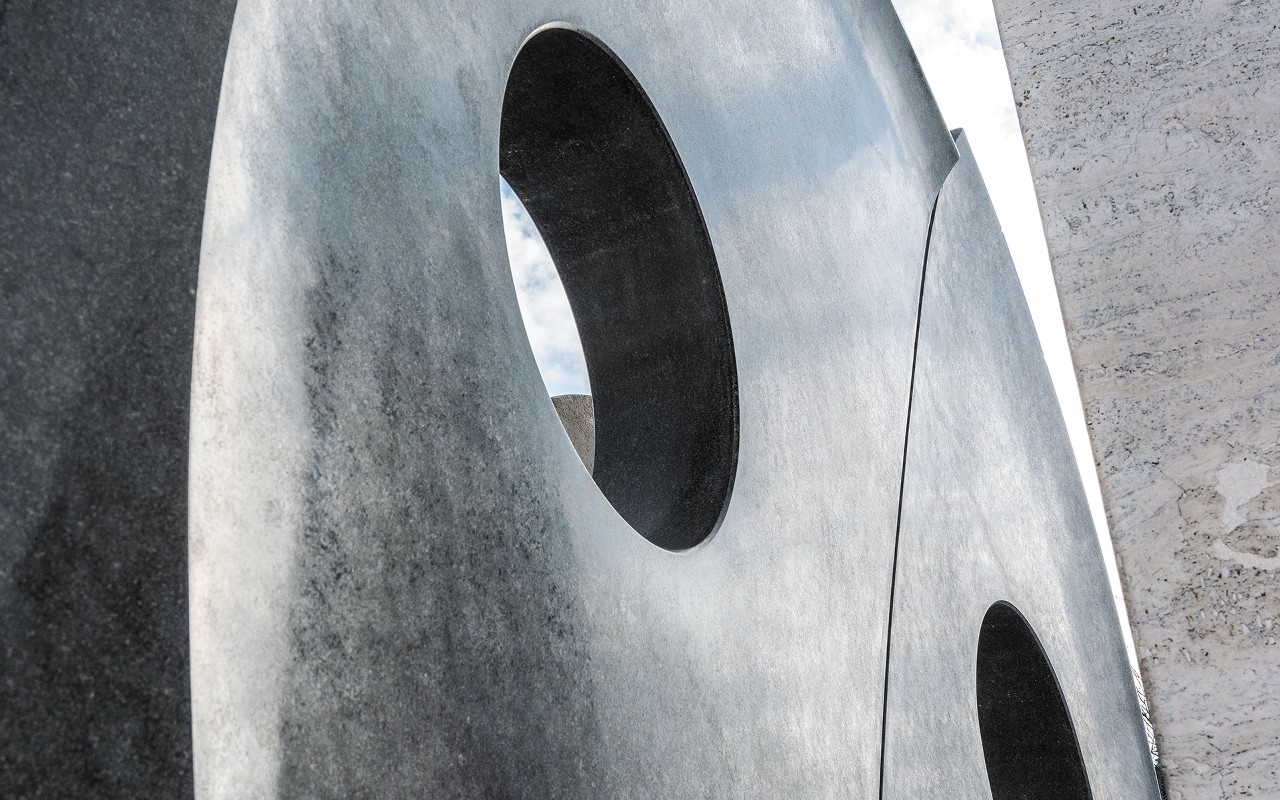
Getting the
Whole Picture
How Villanova’s art collection helps define the history and spirit of the campus we call home
FOR MORE THAN THREE DECADES, AWAKENING HAS BEEN A VILLANOVA LANDMARK, A MEETING PLACE, A PERFORMANCE SPACE, A BACKDROP FOR WEDDING PHOTOS AND MORE. In 2011, it was moved from its original position in front of the Connelly Center to its current location on the Riley Ellipse—no small feat for a 56,000-pound sculpture—where it stands sentinel over rallies, tours and celebrations. When weather and wear have eroded its black marble and travertine slabs, “the Oreo”—as it is often referred to—has been painstakingly restored. It is an iconic piece of public art that has become beloved by generations of Villanovans.
But Awakening is by no means the only piece of art that enriches and inspires on campus. Throughout the history of Villanova, art has been intentionally incorporated into secular and religious spaces as a means of sparking creativity, encouraging inquiry and embodying the Augustinian traditions upon which the community is founded.
Professor Emeritus of Philosophy John Immerwahr, PhD, who in his retirement has become a guide (or docent) for the Philadelphia Museum of Art, reflects, “Villanova’s mission stresses the importance of developing community members as whole persons, including not only our intellectual and social skills, but also the emotional, spiritual and cultural sides of life. Art develops just those qualities.”
“ Art doesn’t always need to be the centerpiece of the space; it can subtly set the tone for the kinds of interactions you hope will take place there. ”
- Jennie Castillo, Curator of the University Art Collection and Gallery Director
As campus has evolved, so too has the variety and placement of the artwork on display. Today, a student may encounter an abstract oil painting, a sculpture that tells a New Testament story and a Baroque masterpiece, all in a morning’s walk across campus. The growth of the University’s art collection was a passion project of the late Rev. Richard G. Cannuli, OSA, MFA, ’73 CLAS, a gifted artist who served as curator of the collection and director of the Villanova University Art Gallery for more than 40 years.
When Father Richard joined Villanova in 1979, there were only 73 pieces in the University collection. Over time, he cultivated relationships with donors, steadily growing both the size and reputation of the collection. Today, through the generosity of alumni, patrons and artists themselves, the collection comprises more than 9,000 works of art, including paintings, sculptures, photographs, textile works, pottery, relics and dozens of other media.
When Jennie Castillo, new curator of the University Art Collection and Gallery Director, started familiarizing herself with the collection in July 2021, she was unprepared for just how many exciting discoveries she would make. She says, “We have treasure troves of incredible pieces in storage right here on campus. The first show I curated for the Gallery was called, Modern Masters: Works on Paper from the Collection, and it featured Frank Stella, Robert Motherwell, Jasper Johns, Marc Chagall, William Baziotes and other giants of the art world—and those were only a sampling of what’s in the collection.”
Castillo is eager to share the University collection with the community by continuing to place significant pieces of art in locations throughout campus.
She also hopes to expand programming in the Art Gallery, which is located on the second floor of the Connelly Center.
She says, “Art has reverberations in history, religion, theatre and dance, the sciences, math—the potential to make connections throughout the curriculum is almost limitless.”
Some of the artwork on display throughout campus is immediately recognizable by most of the Villanova community, while other pieces are hidden gems. Every piece has its own unique story.
In this tour of a selection of the artwork of Villanova, we invite you to take a fresh look at familiar pieces, and possibly discover a new favorite to visit on your next walk across campus.
Portrait of Very Rev. John J. Fedigan
Artist: Thomas Eakins (1844–1916); Medium: Oil on canvas; Date: 1902; Size: 89 ½” x 52”; Location: St. Augustine Center
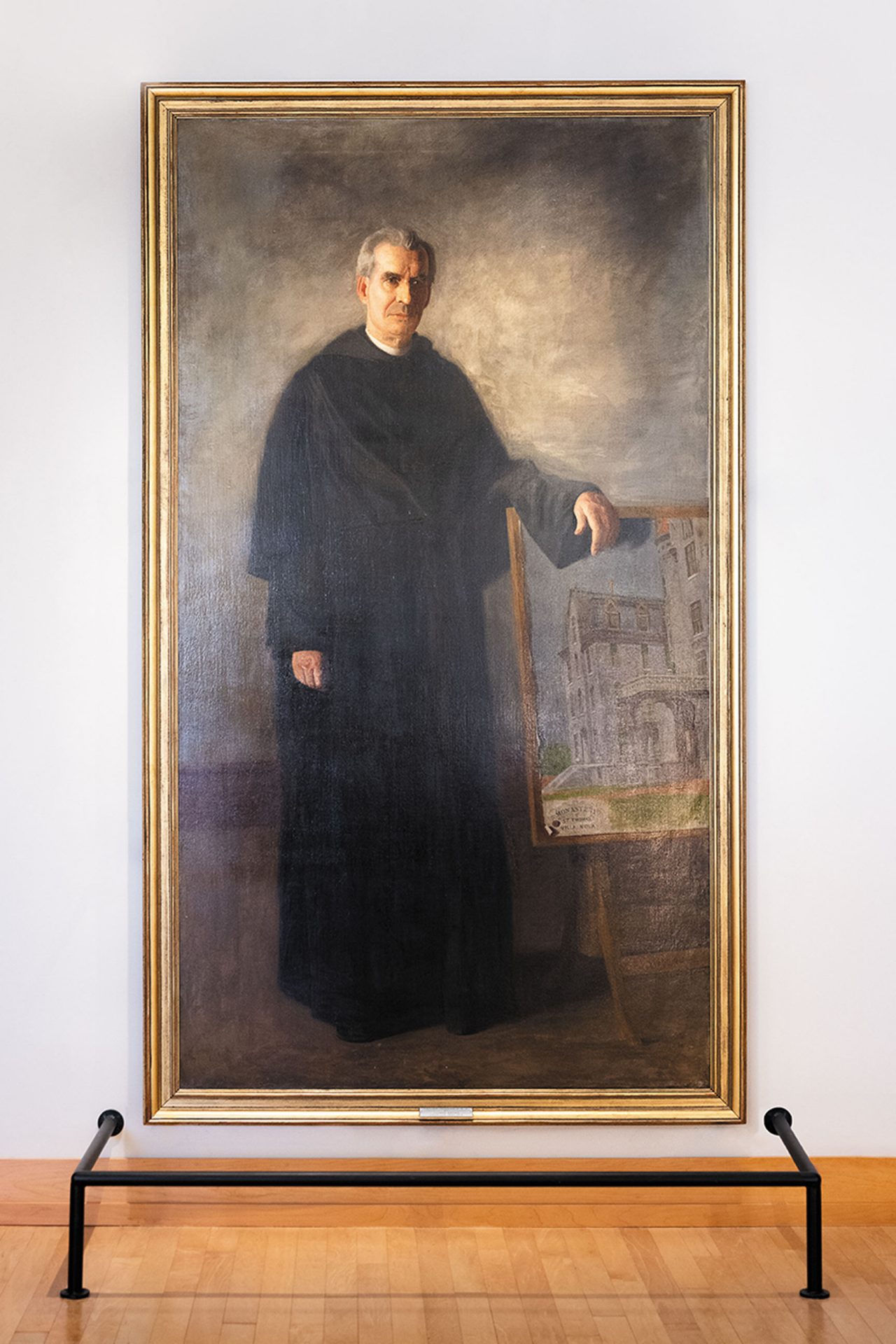
Thomas Eakins is widely acknowledged to be one of America’s most important painters, and his portraits and scenes from life hang in the nation’s most revered galleries. He was a realist painter, sculptor, photographer and teacher of fine arts who lived and worked for most of his life in Philadelphia.
The Rev. John J. Fedigan, OSA (1842–1908), served as president of Villanova College from 1878 to 1880. When he was elected Prior Provincial in 1898, Father Fedigan made it his mission to elevate Villanova into one of the finest Catholic colleges in the nation. His skeptics were vocal, but Father Fedigan raised $275,000 (a monumental sum for the time) and oversaw the erection of Tolentine Hall and the Monastery. The buildings were completed in 1900, marking a new era of expansion for Villanova.
This portrait of Father Fedigan, painted in 1902, is impressive on its own merit—Eakins himself once listed it among his 20 finest works—but as a window into Villanova’s history, it is truly remarkable. Father Fedigan appears in his traditional black wool habit, his arm resting—perhaps a bit wearily—on a drawing of Tolentine. Eakins has at once captured Father Fedigan’s determination, his dignity and his humanity.
Father Fedigan was only 66 when he died, and he is buried in the Augustinian Community Cemetery on campus.
Untitled
Artist: Lucille Ireland (dates unknown); Medium: Acrylic on paper; Location: Charles Widger School of Law law clinic, Scarpa Hall
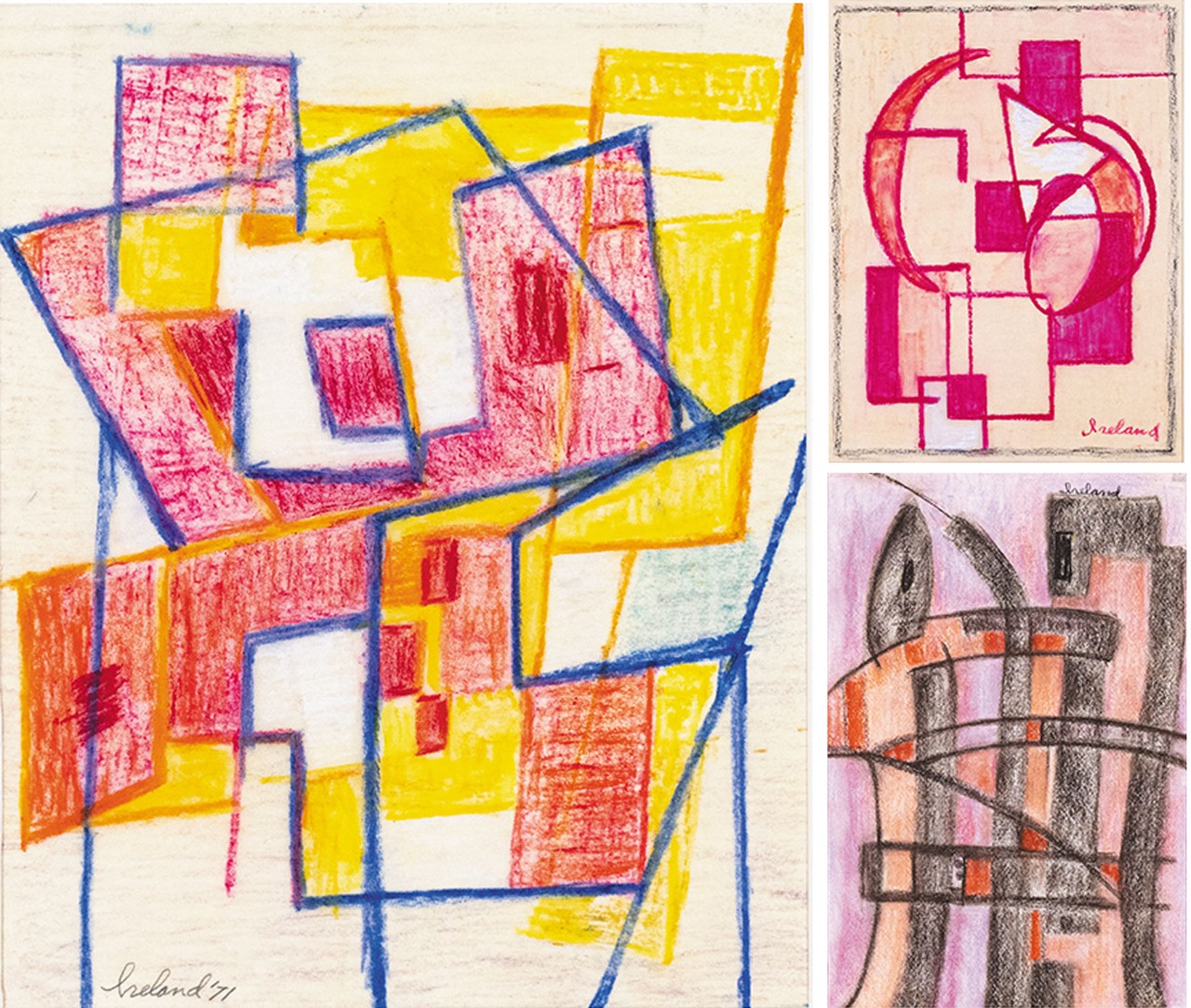
Lucille Ireland was an abstract painter who lived on Philadelphia’s Main Line and exhibited in New York City during the 1950s. Her work is just one example of hundreds of pieces in the University collection by artists from throughout the Philadelphia area. In preserving, archiving and exhibiting the work of area artists, Villanova’s collection safeguards the artistic history and evolution of its regional art community.
Castillo says, “Installations of artwork in buildings around campus can enhance our environment in powerful ways. In the case of these Lucille Ireland paintings, the bright colors and abstract shapes make an otherwise unremarkable room feel warm and dynamic. Art doesn’t always need to be the centerpiece of the space; it can subtly set the tone for the kinds of interactions you hope will take place there.”
The John F. Smith III and Susan B. Smith Antique Map Collection
Location: Picotte Hall at Dundale
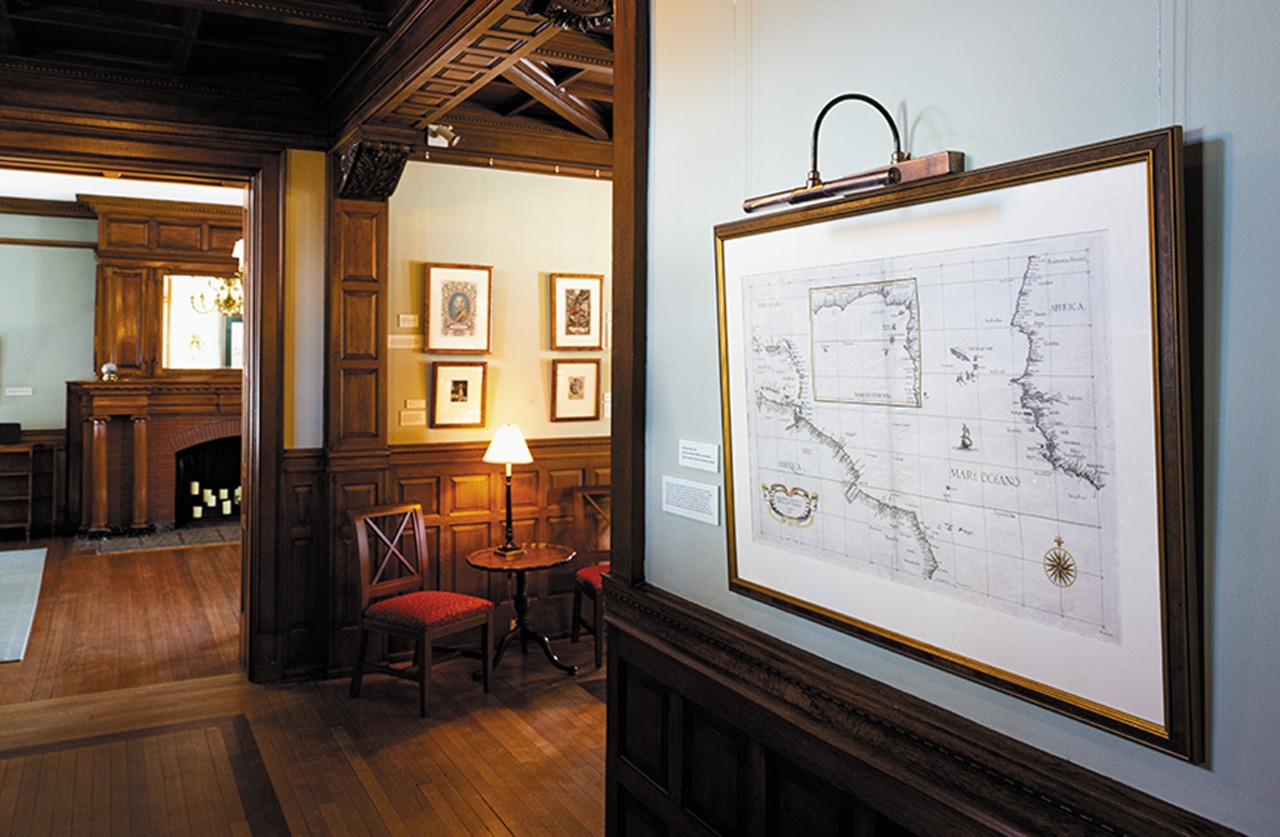
Though the Smith Map Collection is not a part of the University’s art collection, it still merits a stop on a tour of campus’ aesthetic highlights. In 2017, Villanova resident John F. Smith III began donating his collection of some 180 antique maps to Falvey Memorial Library, to be kept in temperature- and humidity-controlled facilities within Falvey’s Distinctive Collections and Digital Engagement department.
In choosing Villanova as the beneficiary of his gift, Smith wasn’t only concerned about the maps’ preservation: He was eager that they be made available to students, faculty, staff and visitors, whether the purpose was serious academic study or simple human curiosity. Taken together, the maps illuminate the evolution of human understanding of our physical world. On an individual basis, each map also reveals the specific perspective and the artistic skill of its maker.
The Distinctive Collections team will display selections from the Smith Map Collection on a rotating basis, so that the community will have ongoing access to this unique window into the past. There are currently 33 maps from the collection on display to the public in Picotte Hall at Dundale.
Had Gadya (Illustrations after El Lissitzky)
Artist: Frank Stella (b. 1936); Medium: Various printmaking techniques on paper; Location: The Inn at Villanova
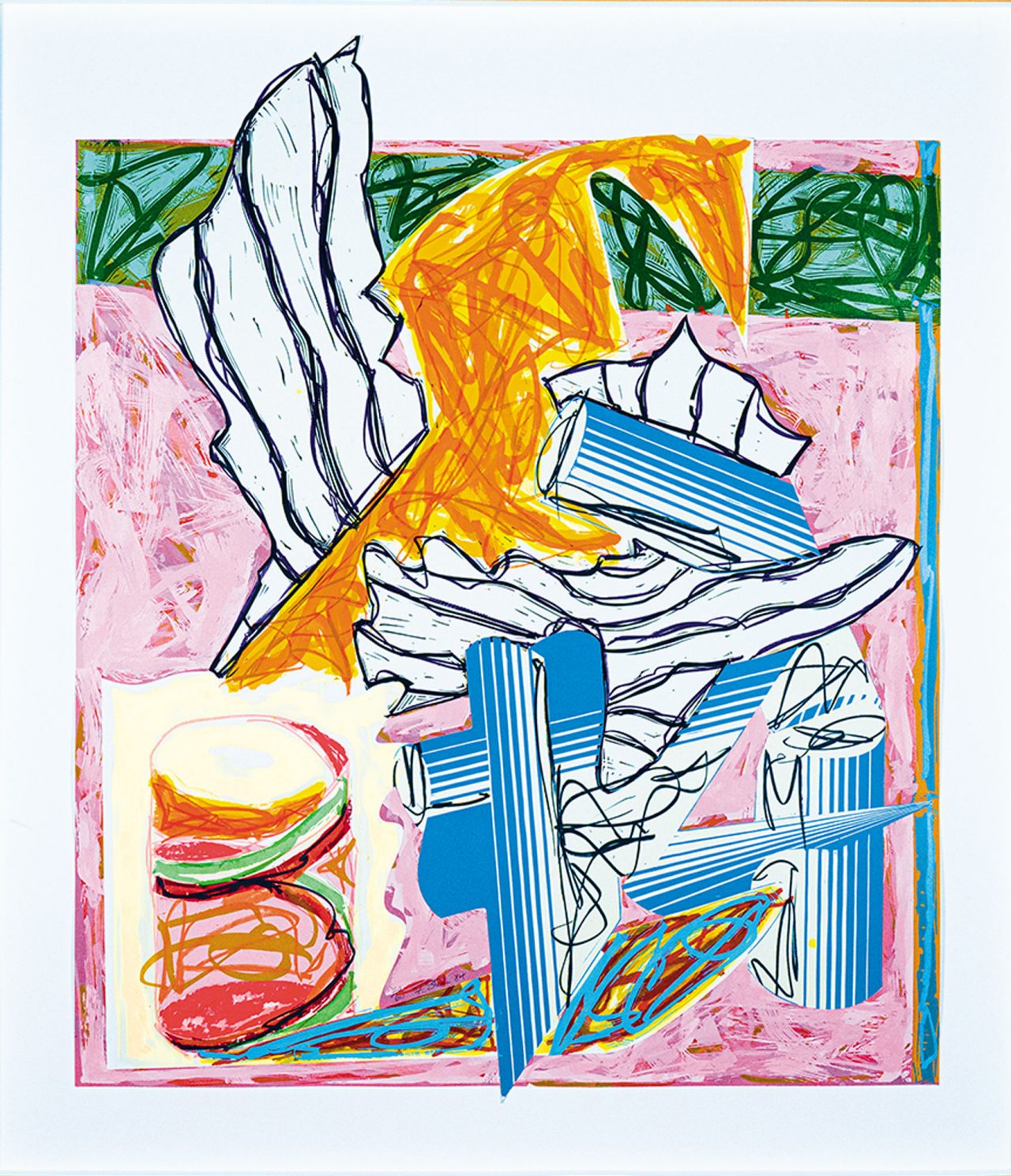
The “Had Gadya” is a playful cumulative song sung at the end of the Passover Seder, the Jewish feast that marks the end of the Passover holiday
In 1981, the American painter, sculptor and printmaker Frank Stella was intrigued by a 1919 series of gouaches by Russian painter El Lissitzky, inspired by the verses of the “Had Gadya.” Stella created his own responses to Lissitzky’s paintings, employing lithography, linoleum block, silkscreen and rubber relief, with elements of collage and hand-coloring.
Villanova’s Had Gadya series is currently on display in the Inn at Villanova, but Castillo featured four in the recent “Modern Masters” exhibit in the Gallery. She says, “The students really responded to them because they have punchy colors and fresh, interesting forms. They’re a perfect example of something truly special in Villanova’s collection.”
Calypso Verse I
Artist: Ellon Lewis (b. 1956); Medium: Oil on canvas; Size: 36” x 84”; Location: Scarpa Hall
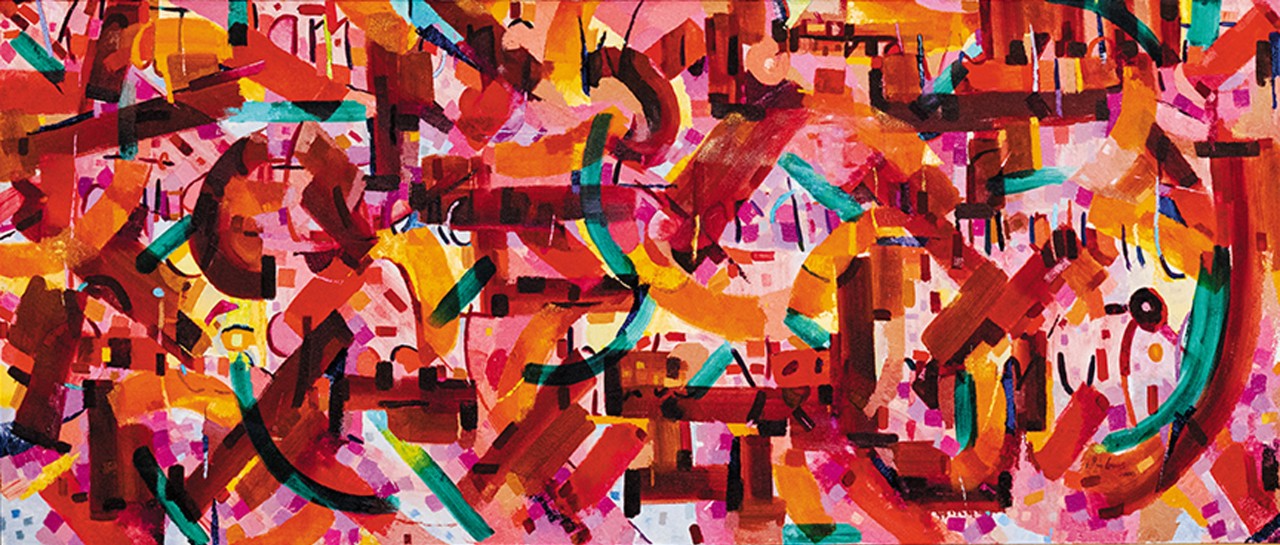
In January 2006, the Art Gallery celebrated a significant gift from an anonymous donor: The Post-Colonial Caribbean Art Repository—27 paintings and sculptures by 21 artists, along with video interviews, books and reviews of their work—had found a permanent home as part of Villanova University’s collection.
Pieces in the repository were produced between 1962 and 1999, a time period that marked many Caribbean nations’ first generation of independence. To fete the occasion, the gallery hosted a reception with the Barbadian Ambassador to the United States in attendance, along with three of the artists whose work was on display. Ellon Lewis, a multimedia artist born in Grenada, was one of those honored guests.
Lewis first studied art at the Jamaica School of Art and Craft (now Edna Manley School of the Visual and Performing Arts) before pursuing a Master of Fine Arts degree at the Pennsylvania Academy of the Fine Arts. He then returned to the Caribbean, moving to Barbados, where he has been teaching and practicing his art. He currently serves as director and curator of The College of Contemporary Art Museum, Barbados.
Hot Dog Cart
Artist: Fumio Yoshimura (1926–2002); Medium: Linden wood; Location: Connelly Center, Second Floor Commuter Lounge
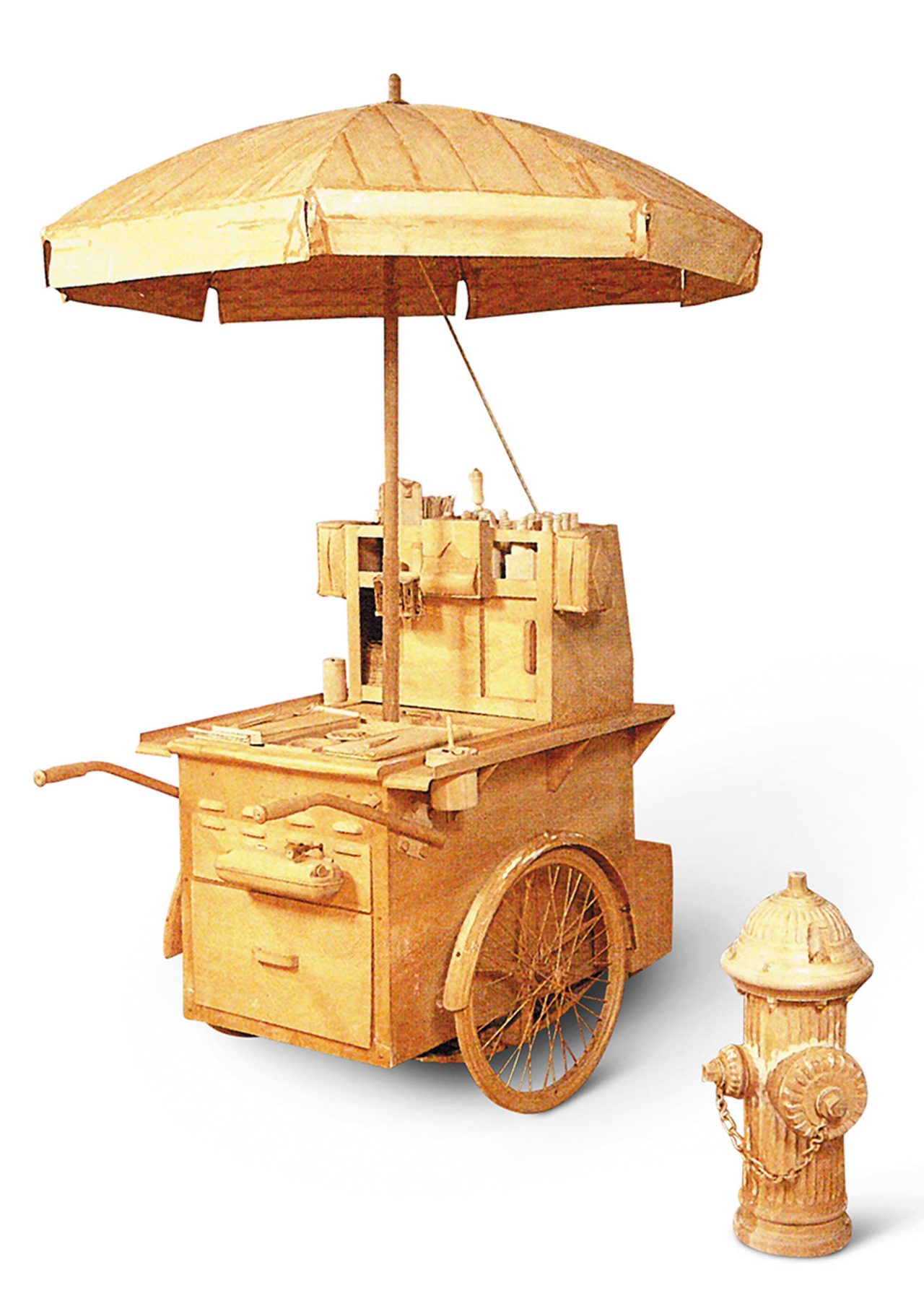
Visitors to the Commuter Lounge who have noticed this intricately carved wooden hot dog cart may have marveled at the exquisite detail carved into each condiment bottle, the gently curving napkin seeming to fall from the dispenser, and even the crushed soda can some (possibly wooden) customer tossed to the ground long ago.
It is the work of Fumio Yoshimura, an artist who studied painting in his native Japan before moving to New York in 1962 and teaching himself wood carving. Yoshimura became known for his painstaking technique, creating exact yet unpainted replicas of mundane objects, inviting the viewer to see them as the “ghost” of the original item. In its obituary of Yoshimura, the New York Times referred to this very work, saying, “[H]is most elaborate works, like a full-size hot dog cart, often took months to complete.”
Hot Dog Cart was donated to Villanova in 1993 by Benjamin D. Bernstein, a longtime friend of the Gallery and an avid patron of the arts throughout the Philadelphia area. The University collection also includes three of Yoshimura’s linden wood bicycles, which used to hang in Belle Air Terrace.
The Triumph of David
Artist: Pietro da Cortona (1596–1669); Medium: Oil on canvas; Location: Dugan-Polk Reading Room, Falvey Library
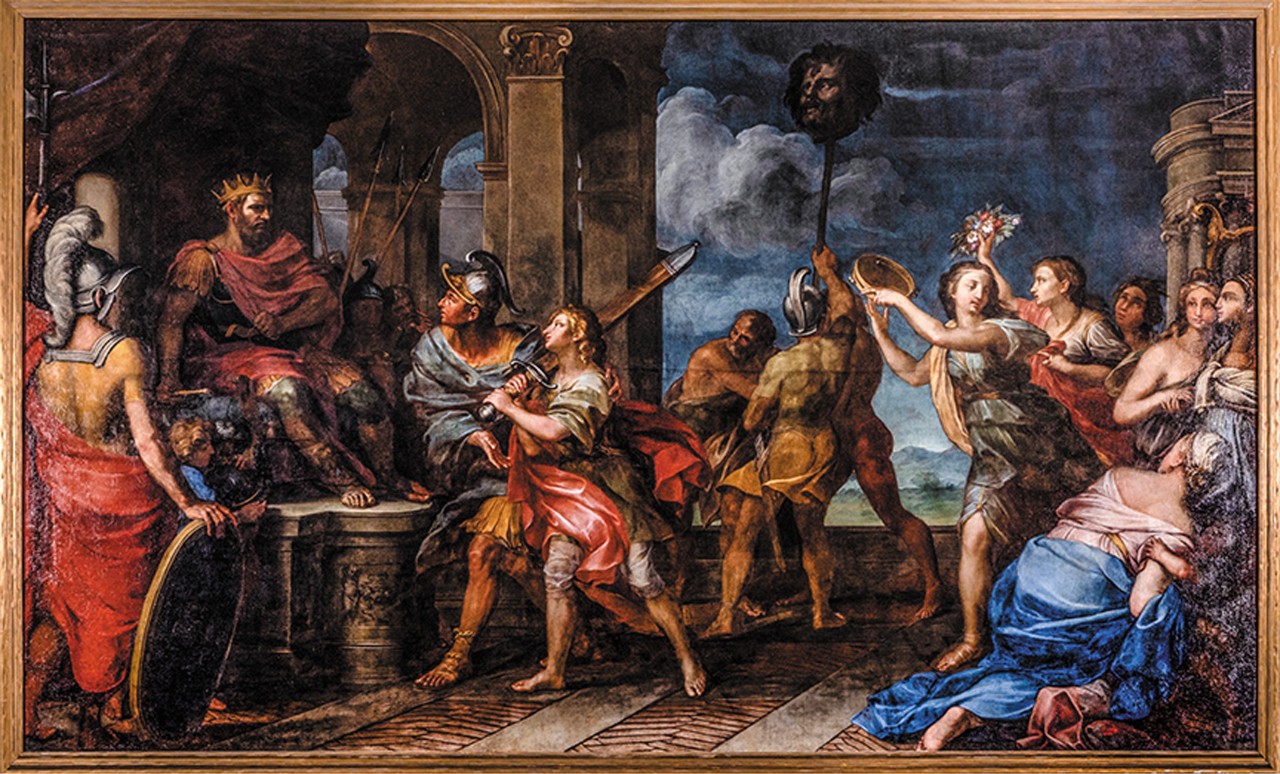
This is one of the largest paintings in the University collection, stretching 20 feet across and 12 feet high. It is associated with Italian painter Pietro da Cortona, one of the most influential Italian Baroque painters and architects of the 17th century, likely done in his style either by his apprentices or his followers. The painting depicts one of the most well-known stories from the Old Testament: David, the archetypal underdog, has slain the massive Goliath with a stone thrown from his sling. Here, he has cut off the giant’s head and is presenting it to King Saul as proof of the Israelites’ victory over the Philistines.
Around 1938, the Princess Eugenia Ruspoli (1861–1951), American by birth and Italian royalty by marriage, added The Triumph of David to her significant personal collection. After fleeing pre-war Europe to make her home in New York City, the princess donated artwork to churches, universities and other institutions. Between 1949 and 1950, Ruspoli donated the Cortona and several other pieces of art into the care of the Rev. Daniel P. Falvey (1906–1962), the former library director for whom Falvey Memorial Library is named. According to Villanova University Art Collection: A Guide (1986), Father Falvey believed that “[t]he aesthetic pleasure of viewing the paintings would enhance any student’s visits to do research.”
The Triumph of David has hung in its current location since 1950, but over time the painting’s overpaint and varnish coatings had degraded and darkened, leaving the image dull and mottled. In 2013, an interdisciplinary team of conservators, art historians and scientists—including Villanova faculty and students—began a painstaking two-year campaign of conservation.
The result is what we see today: brilliant colors, the complex interplay of light and shadow, and figures who seem vibrant enough to leap from the canvas.
Augustine the Teacher
Artist: Peggy Mach (1922–2013); Medium: Bronze; Date created: 1998 (with additions in 2001 and 2007); Location: In front of the St. Augustine Center

The installation of Augustine the Teacher in 1998 was part of an effort by Assistant to the President the Rev. Kail Ellis, OSA, PhD, then dean of the College of Liberal Arts and Sciences, to integrate art—and specifically art that represents Augustinian values—into the everyday experience of students, faculty and staff. Initially, just two figures were dedicated: St. Augustine and the young man across from him.
In 2001, sculptor Peggy Mach created the female student who now stands to St. Augustine’s right. Then in 2007, a gift from Barry Johnson ’70 COE made possible the addition of the African American student to St. Augustine’s left. The evolution of Augustine the Teacher reflects not only the centrality of the pursuit of wisdom in the Augustinian tradition, but also the importance of diversity—of thought, culture and perspective—on campus.
The inscription on the brass plate mounted on the curved wall behind Augustine the Teacher reads:
“So great is the influence of a sympathetic mind that our students are affected by us as we teach and we by them as they learn. Thus we come to dwell in each other; they speak within us what we hear, while we learn in them what we teach.”
– St. Augustine, Instructing Beginners in Faith, 12, 17
Servant of God the Rev. William E. Atkinson, OSA
Artist: The Rev. Richard G. Cannuli, OSA (1947–2019); Medium: Stained glass; Location: Corr Chapel
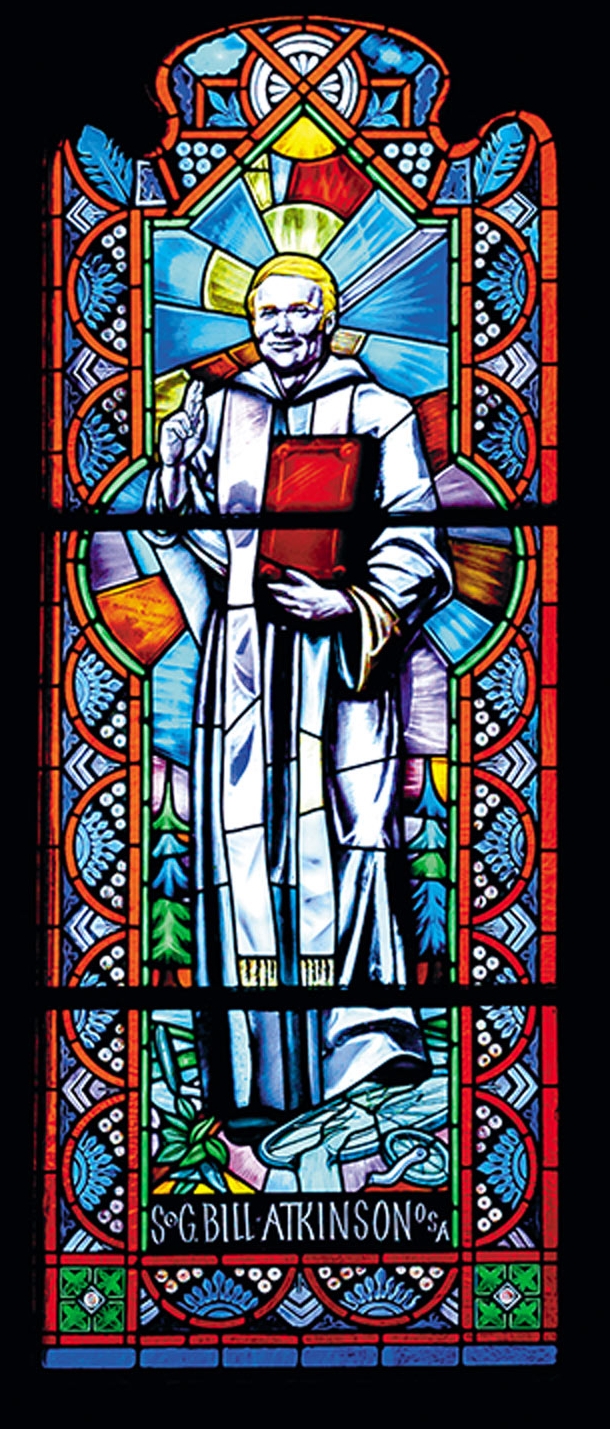
Between 2006 and 2020, eight plain frosted-glass windows in Corr Chapel were replaced with the jewel-toned works of art that distinguish the chapel today. Designed by the late Rev. Richard G. Cannuli, OSA, MFA, ’73 CLAS, they were crafted in a stained-glass workshop in Siena, Italy.
Installed in 2019, this window pictures Servant of God William E. Atkinson, OSA, ’73 CLAS—Father Bill to his friends—the first quadriplegic ever ordained as a Catholic priest. He is currently being considered by the Vatican for sainthood. As an Augustinian novice, Father Atkinson was injured in a tobogganing accident and sustained spinal cord injuries that left him paralyzed from the neck down. He completed his formation in the priesthood at Villanova and went on to teach at Msgr. Bonner High School in Upper Darby, Pa., for almost 30 years.
As depicted in Corr Chapel, Father Atkinson is standing with the pieces of his motorized wheelchair at his feet, to signify that, in death, he was again made whole.